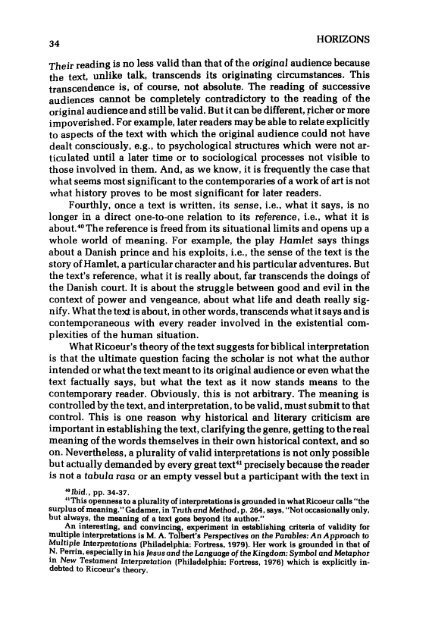FROM EXEGESIS TO HERMENEUTICS - Rice School of Pastoral ...
FROM EXEGESIS TO HERMENEUTICS - Rice School of Pastoral ...
FROM EXEGESIS TO HERMENEUTICS - Rice School of Pastoral ...
Create successful ePaper yourself
Turn your PDF publications into a flip-book with our unique Google optimized e-Paper software.
34 HORIZONSTheir reading is no less valid than that <strong>of</strong> the original audience becausethe text, unlike talk, transcends its originating circumstances. Thistranscendence is, <strong>of</strong> course, not absolute. The reading <strong>of</strong> successiveaudiences cannot be completely contradictory to the reading <strong>of</strong> theoriginal audience and still be valid. But it can be different, richer or moreimpoverished. For example, later readers may be able to relate explicitlyto aspects <strong>of</strong> the text with which the original audience could not havedealt consciously, e.g., to psychological structures which were not articulateduntil a later time or to sociological processes not visible tothose involved in them. And, as we know, it is frequently the case thatwhat seems most significant to the contemporaries <strong>of</strong> a work <strong>of</strong> art is notwhat history proves to be most significant for later readers.Fourthly, once a text is written, its sense, i.e., what it says, is nolonger in a direct one-to-one relation to its reference, i.e., what it isabout. 40 The reference is freed from its situational limits and opens up awhole world <strong>of</strong> meaning. For example, the play Hamlet says thingsabout a Danish prince and his exploits, i.e., the sense <strong>of</strong> the text is thestory <strong>of</strong> Hamlet, a particular character and his particular adventures. Butthe text's reference, what it is really about, far transcends the doings <strong>of</strong>the Danish court. It is about the struggle between good and evil in thecontext <strong>of</strong> power and vengeance, about what life and death really signify.What the text is about, in other words, transcends what it says and iscontemporaneous with every reader involved in the existential complexities<strong>of</strong> the human situation.What Ricoeur's theory <strong>of</strong> the text suggests for biblical interpretationis that the ultimate question facing the scholar is not what the authorintended or what the text meant to its original audience or even what thetext factually says, but what the text as it now stands means to thecontemporary reader. Obviously, this is not arbitrary. The meaning iscontrolled by the text, and interpretation, to be valid, must submit to thatcontrol. This is one reason why historical and literary criticism areimportant in establishing the text, clarifying the genre, getting to the realmeaning <strong>of</strong> the words themselves in their own historical context, and soon. Nevertheless, a plurality <strong>of</strong> valid interpretations is not only possiblebut actually demanded by every great text 41 precisely because the readeris not a tabula rasa or an empty vessel but a participant with the text in40 Ibid., pp. 34-37.41 This openness to a plurality <strong>of</strong> interpretations is grounded in what Ricoeur calls "thesurplus <strong>of</strong> meaning. "Gadamer, in Truth and Method, p. 264, says, "Not occasionally only,but always, the meaning <strong>of</strong> a text goes beyond its author."An interesting, and convincing, experiment in establishing criteria <strong>of</strong> validity formultiple interpretations is M. A. Tolbert's Perspectives on the Parables: An Approach toMultiple interpretations (Philadelphia: Fortress, 1979). Her work is grounded in that <strong>of</strong>N. Perrin, especially in his Jesus and the Language <strong>of</strong> the Kingdom; Symbol and Metaphorin New Testament Interpretation (Philadelphia: Fortress, 1976) which is explicitly indebtedto Ricoeur's theory.



